Razer Phone 2
To look at the new phone from Razer, especially from the front, you wouldn’t really know this was the Razer Phone 2, it’s so similar to last year’s model – Razer is clearly channelling its inner Apple or Samsung, with bold confidence in the original’s design.
Heck, even Apple has introduced a new color option in this year’s iPhone XS range – with the Razer Phone 2, you get black with a mirror finish or black with a matte finish.
Flip the phone around and the back starts to reflect some key differences between it and its predecessor. Specifically, a sheet of flat glass as opposed to last year’s all-metal body.
Glance over the spec sheet and you’ll also notice the internals have been boosted in the Razer Phone 2, with a Snapdragon 845 chipset inside, and the addition of wireless charging and IP67 dust and water resistance.
Razer has also taken on board feedback from fans and critics, illuminating the logo on the back of the phone with a full spectrum of RGB colors. The max screen brightness has also been leveled up to a much more respectable 645 nits, in contrast to the paltry 300 nits of the original Razer Phone.
As for the features making a return, you have 8GB RAM, 64GB of storage with microSD expansion, dual rear cameras, killer stereo speakers, a 4,000mAh battery and a 120Hz IGZO display.
So this thing will be excellent for gaming, that’s a given – for power, sound, screen and ergonomics, this phone nails it. The real point of this review is to ask: will this phone be good for the ‘life’ stuff too?
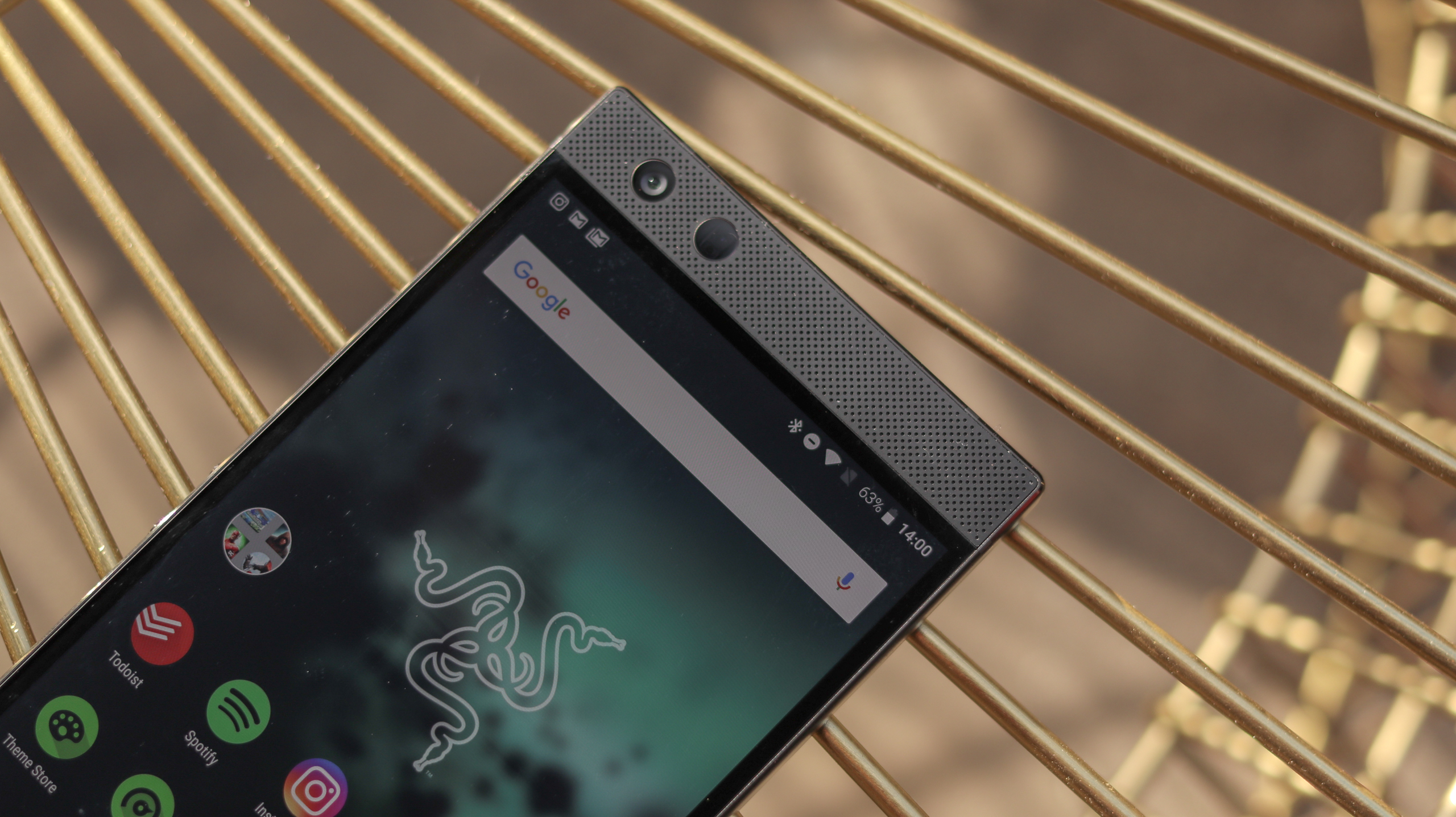
Razer Phone 2 release date and price
The Razer Phone 2 price is set at $799 (£779, around AU$1,200), which is $100 (£80, around AU$100) more expensive than its predecessor at launch.
It's not a huge surprise that the price has been increased – it's common practice across the mobile industry – but with this device the price hike feels less warranted than in other cases, given how similar the new phone looks to its predecessor. Clearly, wireless charging, IP ratings and Chroma RGB goodness don’t come cheap.
As for the Razer Phone 2 release date, you can pick up the Mirror Black version now. The Stain Black version will be available later in the year, with availability in the US, Europe and Asia-Pacific also expected.
Key features
According to Razer, the Razer Phone 2’s raison d’etre is to be the best gaming phone around, and an excellent all-round smartphone too. This explains a number of decisions made here, specifically when it comes to the phone’s design.
The phone is boxy, angular and bold, just like the first Razer Phone. The flat sides make it comfortable to hold when gaming in landscape orientation, while the front-firing stereo speakers are all but impossible to cover up – so when you’re first-person-shooting or dungeon-sword-swinging, every bang and clang will be directed squarely at you.
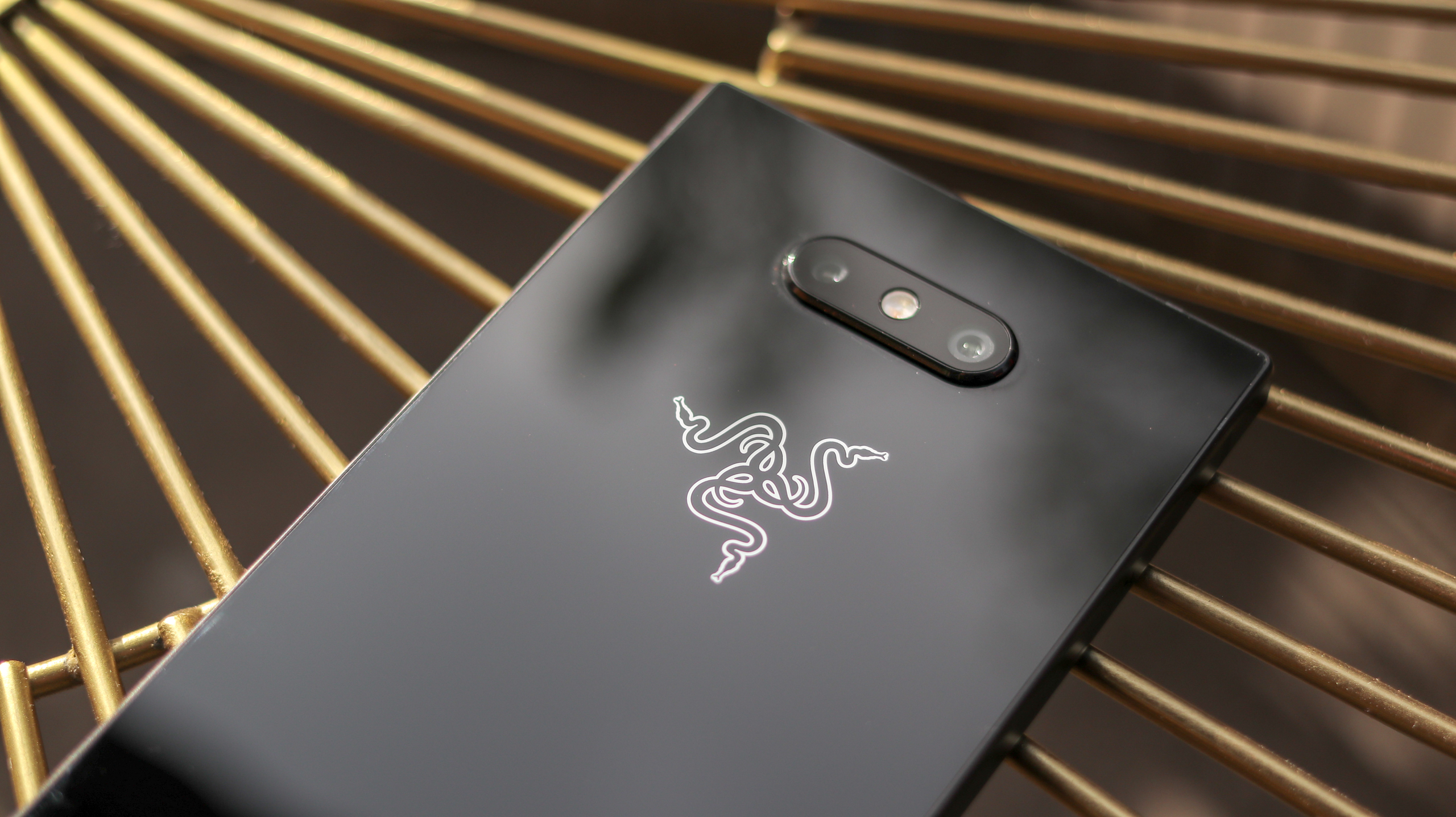
It may be bold, but the Razer Phone 2 is also simple from a design point of view – it’s a cuboid. Looks-wise, this makes it more accessible than the overtly gamer-centric Asus ROG phone, which by contrast looks like a Transformer velociraptor.
Meanwhile, the screen’s 120Hz refresh rate is silky, enhancing the experience of simple swipes through menus or twitter feeds, as well as enhancing optimized and unoptimized gameplay alike. HDR support also means video content can look rich, with services including Amazon Prime Video, Netflix and YouTube offering HDR content.
The power button on the right side of the phone doubles as the fingerprint scanner, while the bottom of the phone houses the USB-C port, with the volume buttons on the left side.
There’s plenty of power under the hood, with the same Snapdragon 845 as found in the Samsung Galaxy Note 9 and Google Pixel 3 XL; in the Razer Phone 2, though, it’s paired with 8GB RAM for even more oomph.
4,000mAh of battery power is, on paper, exceptional, matching the Huawei P20 Pro and falling just short of the current battery king, the Mate 20 Pro, but not all the numbers are class-leading. Looking at storage, 64GB is a bit paltry for a flagship phone intended for gaming, with lower-cost devices like the regular Mate 20 and the OnePlus 6T both packing 128GB storage options at lower price points.
Design
As we've mentioned, from the front the Razer Phone 2 looks virtually identical to its predecessor, with sizable bezels housing the powerful speakers above and below the display, squared-off edges and a side-mounted power/lock key.
The power key also houses the fingerprint scanner, which works quickly and accurately.
Flip the Razer Phone 2 over though and things are more noticeably different. Razer has given the rear of its new phone a Gorilla Glass 5 makeover, and moved the camera bump to a central position at the top of the device.
The bump is much more pronounced than on devices like the Pixel 3, Note 9 and iPhone XS Max, so if you want to make the whole back flush with it you’ll need a case.
The rest of the back is sleek and elegant, a sheet of glass with a light-up Razer logo, employing the brand’s own trademark of RGB – Chroma.
The Chroma app on the phone allows you to customize the logoits color from a choice of 16.8 million hues, and you can also choose from three different states: breathing (shifts brightness up and down), static (keeps light on at one brightness) and cycle (a party mode which cycles through all colors).
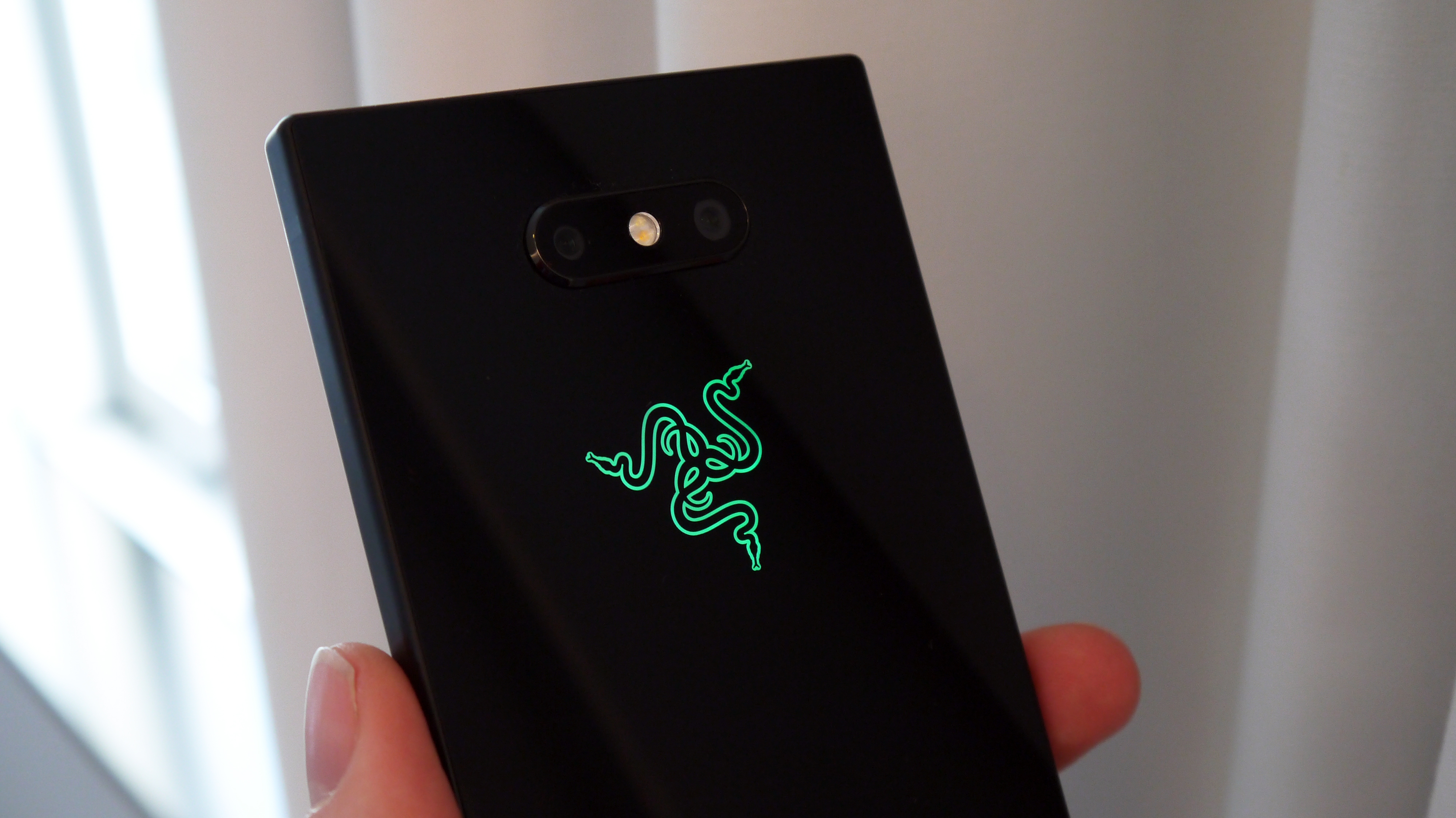
The RBG lighting impacts battery performance, but as we’ll come to, even with it turned on the Razer Phone 2 lasted as long as we needed it to on all but the most intensive of gaming and benchmarking days. Naturally, if you want to save as much power as possible you can switch it off completely.
This takes the grand total of phones loaded up with RGB lighting to… two, with the Razer Phone 2 in good company alongside the Asus ROG phone.
In the hand the edges of the Razer Phone 2 are subtly more rounded that those of its predecessor, making it more comfortable to hold, and the aluminum frame provides a good deal of rigidity to the handset. It’s also nice and durable, with Jerry Rig Everything giving it the thumbs up when it comes to taking a beating, or a bending.
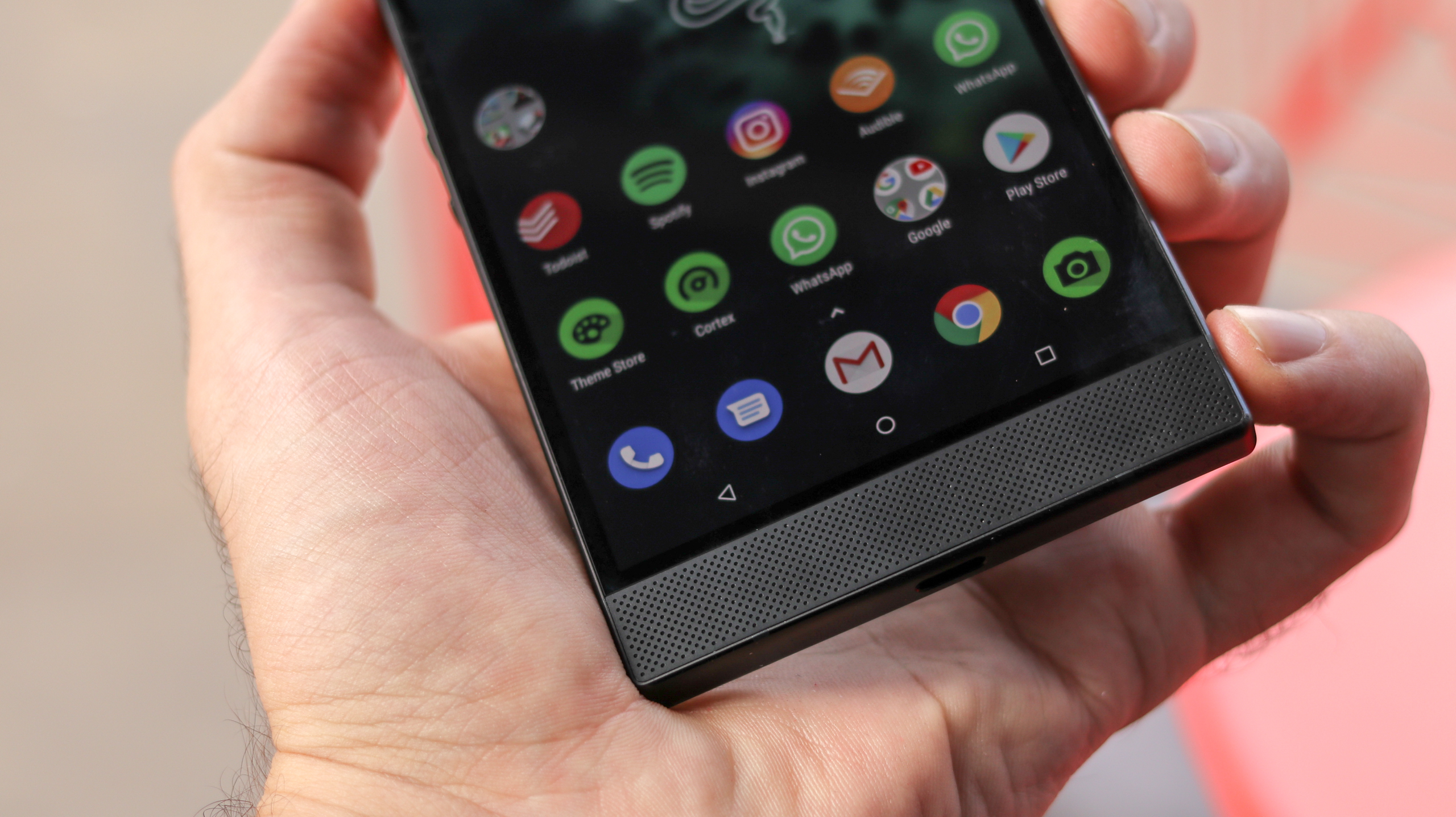
The Razer Phone 2 measures 158.5 x 78.99 x 8.5mm, which makes it ever so slightly bigger than the original – but the difference really is minimal, and you can still use it with one hand.
Many will lament the fact that there's no headphone jack, with a USB-C connection being the only port on the handset, but the Razer Phone 2 does come with a 3.5mm-to-USB-C adapter in the box – and it features a 24-bit DAC for enhanced audio quality, which is a nice bonus.
Comparing this adapter to the one that ships with the Google Pixel 3, Razer’s is indeed superior, with noticeably richer audio reproduction.
This welcome touch nicely complements the dual front-firing stereo speakers, which boast Dolby Atmos and Dolby Digital 5.1 support.
So sure, for gaming, everything checks out – cuboid with banging speakers and RGB lights. It’s bold though, and blocky, so if you’re not a gamer there’s a good chance the Razer Phone 2 might leave you cold before you’ve even looked inside.
Display
The original Razer Phone was meant to be all about that display, with its 120Hz refresh rate and QHD resolution. Despite glimmers of brilliance, however, the IGZO panel made by Sharp ended up being a pain-point in some respects, with low max brightness and duller colors than most competing flagship phones.
The Razer Phone 2 uses the same 5.7-inch QHD 120Hz UltraMotion display as its predecessor on paper, but this time around Razer has enhanced the max brightness by 50%. Brightness now peaks at 645 nits, which will be a blessing to anyone intent on using the phone in direct sunlight.
The phone’s 120Hz refresh rate provides latency-free gameplay, extremely smooth scrolling, and an 8ms response rate. It does draws more power, but you can choose from three presets: 120Hz, or 60Hz or 90Hz if you want to save a little juice.
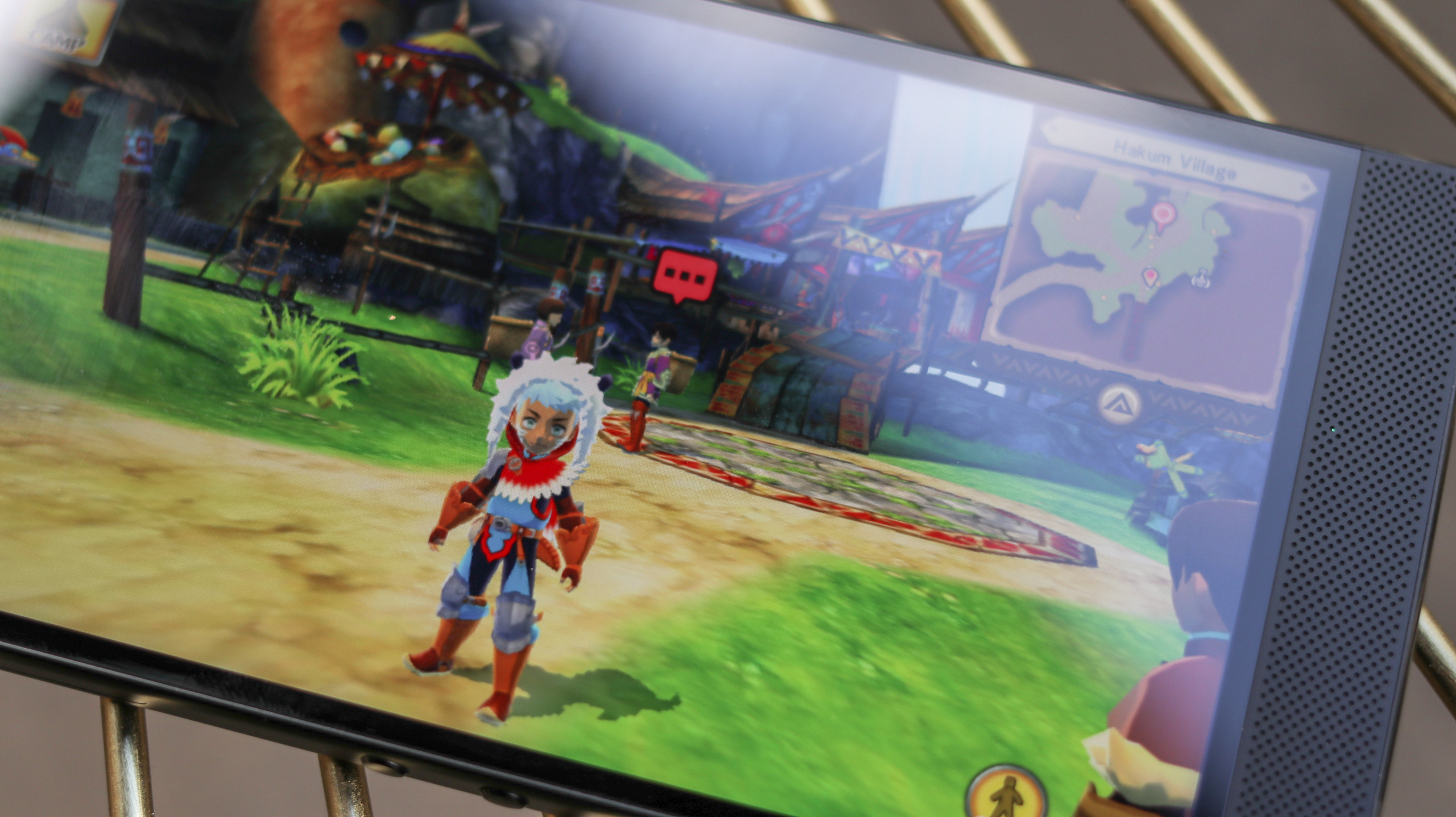
Razer in name and razor by nature, this phone’s screen is sharp, with the 1440 x 2560 resolution delivering 515 pixels per inch. Like the screen refresh rate, the output resolution can also be tuned in the settings, with two options: Full HD or the native resolution of Wide Quad HD.
There are aspects of the screen we’re not sold on though – sticking with a 16:9 aspect ratio for example. Now, this aspect ratio definitely has benefits. It gives you a taller field of view when playing games in landscape, which means that when you’re playing first-person shooters, for example, you won't have to vertically pan the camera to look around as much, saving you precious seconds in the heat of the battle.
In spite of this, though, Razer’s decision to go with 16:9 was still, in our opinion, a big mistake. Side by side in a shop, alongside even last year’s Samsung Galaxy S8 Plus, which you can pick up for £370 less, it just looks old.
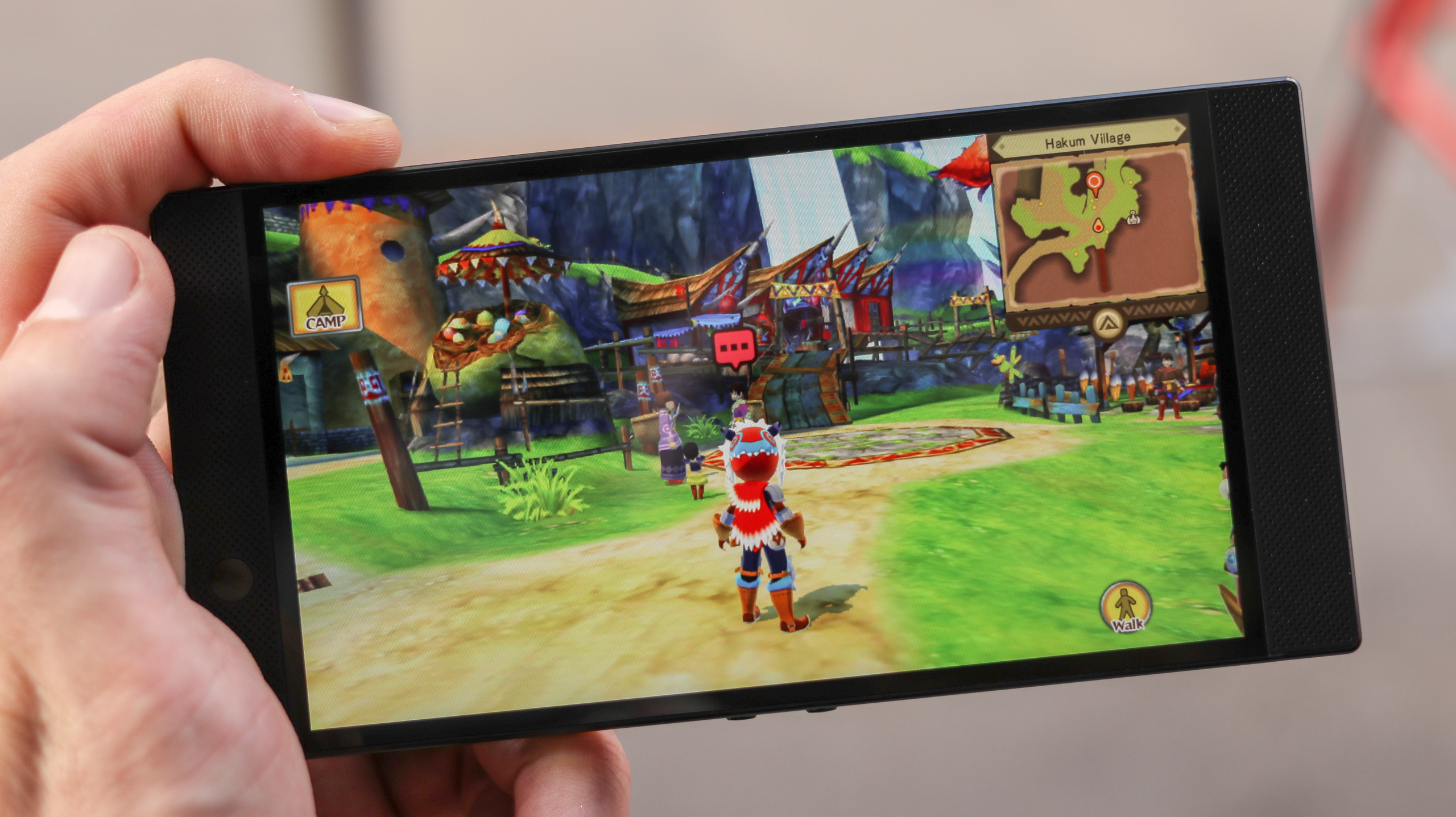
UI
The Razer Phone 2 runs Android 8.1, with Nova Launcher as the default UI and some helpful Razer customizations to fine-tune the gaming experience.
Starting with Android, 8.1, also known as Oreo, this is last year’s version of Google’s Mobile OS. On the one hand, this still supports all the apps and services you’d be getting with the 2019 flavor, Android Pie, but it still isn’t Google’s freshest update.
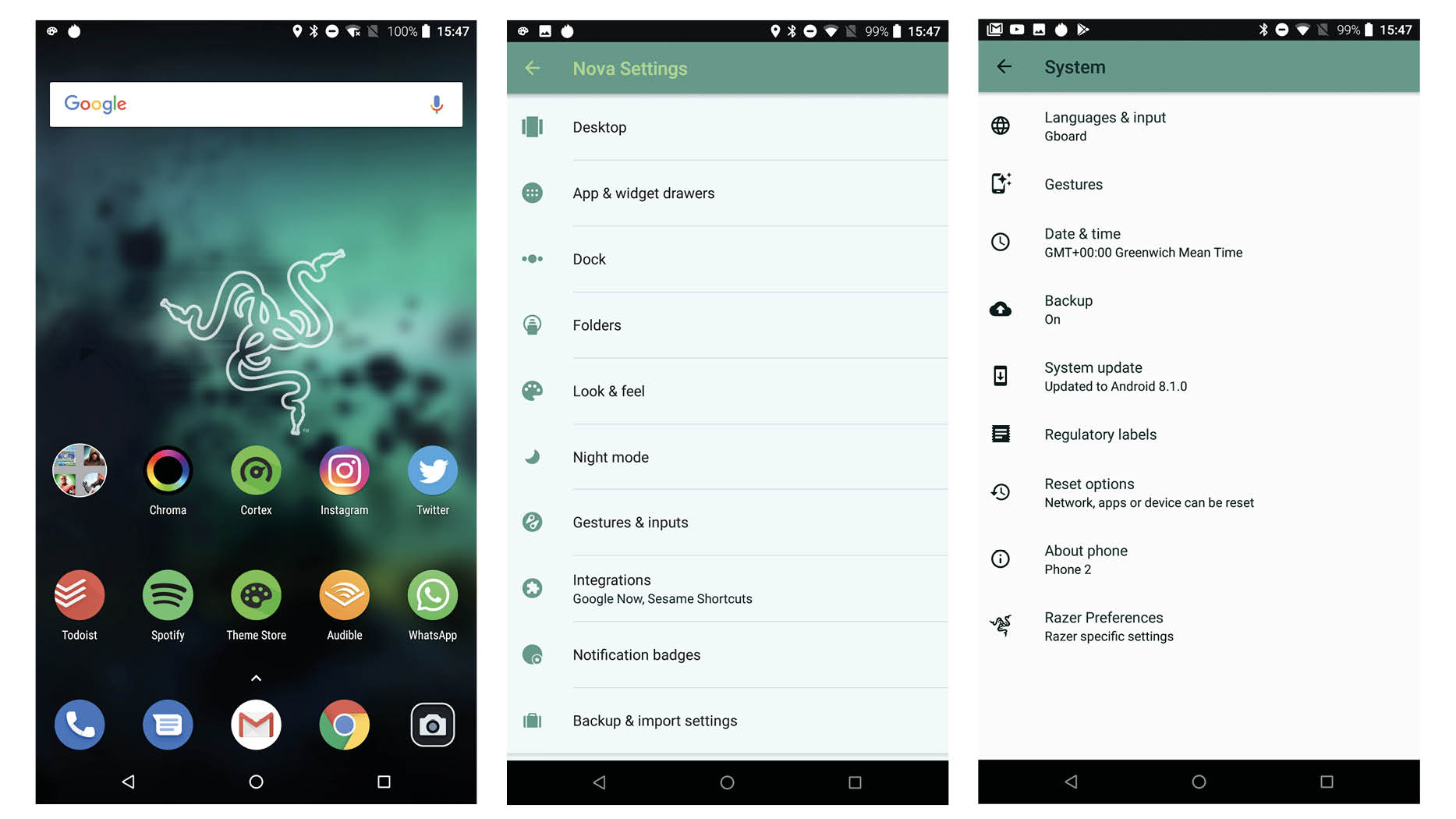
Moving onto Nova Launcher, and this is a very stock-looking, customizable take on the traditional Android interface. You have an apps tray, home screens and a notification bar that you can pull down from the top of the screen.
What’s cool about Nova Launcher is that you can tweak a huge number of elements to personalize your phone. The homescreen grid sizes, for example, are set to 5 x 5, but you can change this to from as few as two to as many as 12 apps wide or tall. The applications tray can be tweaked in a similar way, and you can also create gesture shortcuts.
These gesture shortcuts can be linked to launching applications, firing up settings or engaging with UI elements. For example, a swipe down anywhere on the screen can be set to pull down the notification bar – handy for anyone with smaller hands.
The Razer Phone 2 also has three apps onboard to help you get the most out of it from a gaming, or at least gaming enthusiast, point of view: Chroma, Cortex and Theme Store.
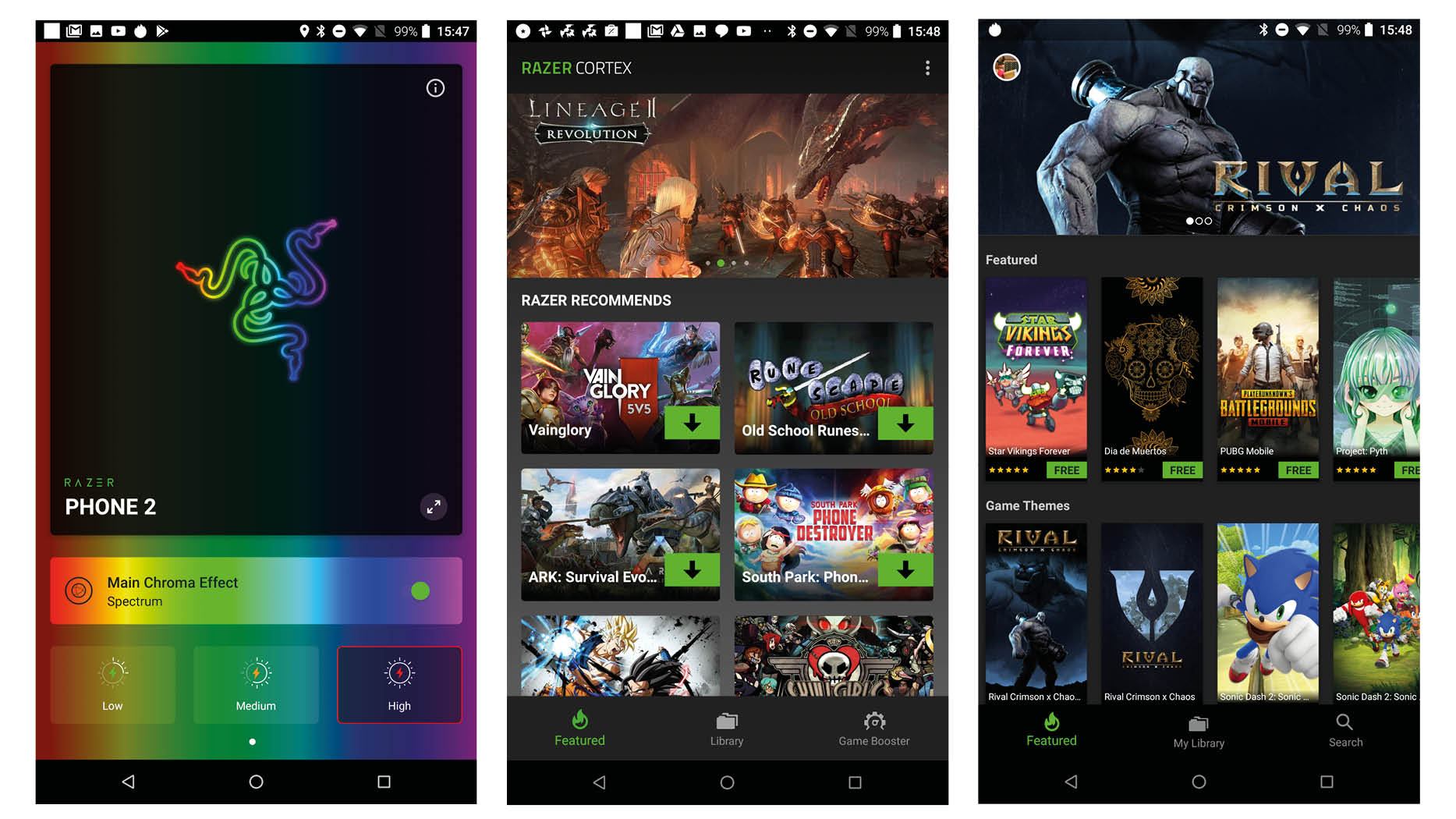
Chroma is the control center for the RGB Razer Logo on the phone’s back. As mentioned, you can set the logo to one of three settings: breathing, static or spectrum. Breathing pulses the logo on and off, static just keeps the logo fired up and spectrum cycles through the color spectrum on offer.
The Cortex app is more directly linked to gaming, with three core elements: Featured – where you can browse Razer recommended games, Library – an area that groups your installed games, and game booster.
Game booster is the place to change the Razer Phone’s power management mode, to Power Save or Performance. If you want to go granular, you can assign specific settings to individual games, clocking the processor as high as 2.8GHz, and firing up anti-aliasing.
Finally, the theme store is a quick way to give your Razer Phone 2 a makeover, with plenty of either gaming or Razer themes available.
There’s nothing in the UI that makes us complain – it’s simple, stable and customizable, with some flourishes both stylistically and in terms of gaming-related enhancements. That it extends to the back of the phone in the form of the Chroma logo is just a sweetener.
Performance
Clocked at 2.8GHz, the Qualcomm Snapdragon processor inside is paired with 8GB RAM. A few weeks before this review going live, this was as good as it got in the Android world from a performance point of view. Then the Huawei’s Mate 20 series dropped, rocking Kirin 980 chipsets.
Talking pure benchmarks - and we know Huawei hasn’t got the cleanest track record with benchmarks - the Mate 20 currently beats out the Razer Phone 2 across both Geekbench and Antutu by a clear margin.
That said, only Huawei phones get Kirin chips, and outside the Huawei - and of course, Apple - worlds, the Razer Phone 2 reigns supreme, with a Geekbench multi-core score of 8,898.
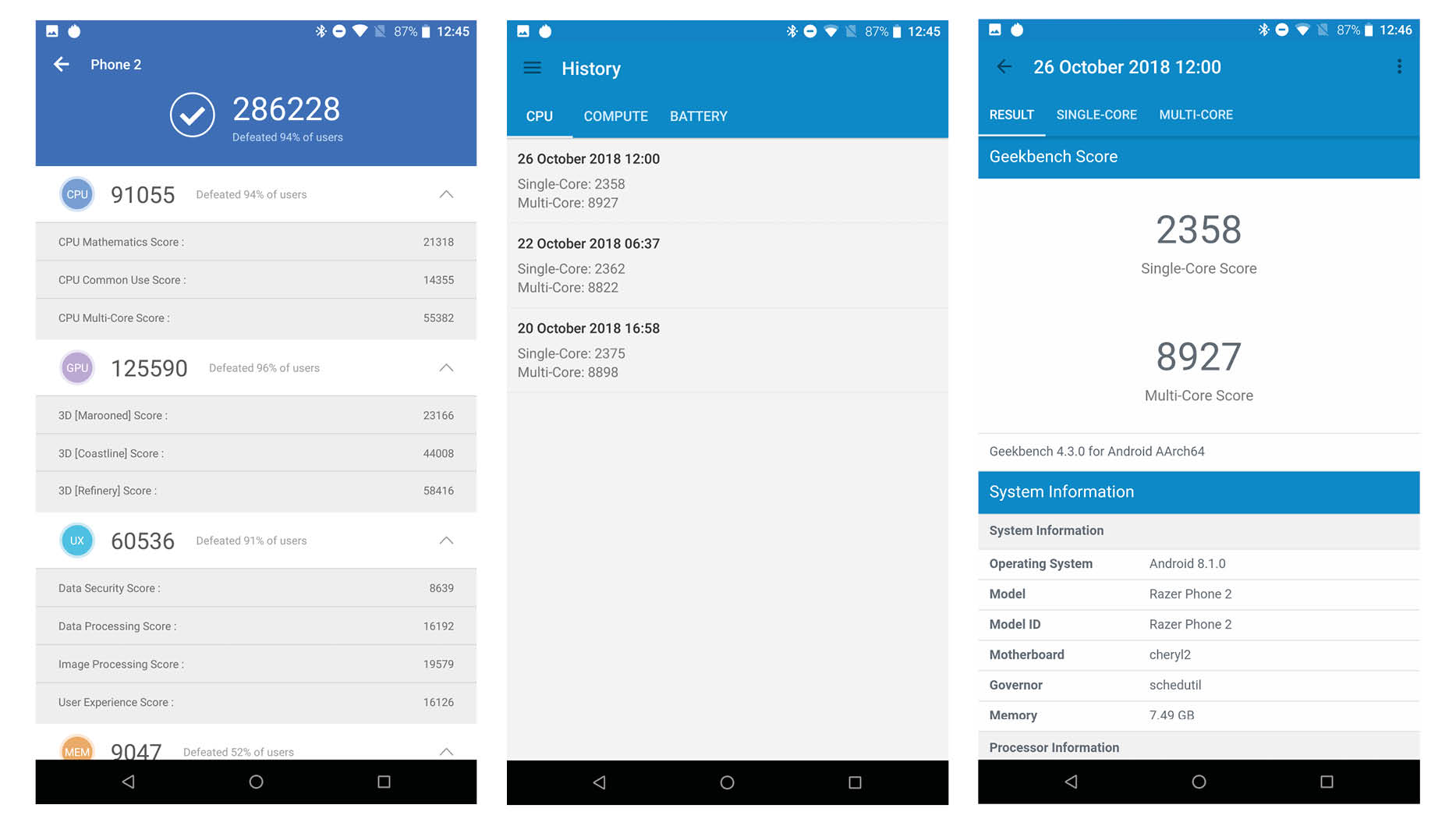
As for actual gaming performance, all Snapdragon 845 phones are excellent, and the Razer Phone 2 is no different. A vapor-chamber cooling system allows heat to spread throughout the phone via a custom vapor chamber. According to Razer, this results in fewer hot spots and greater performance and stability compared to traditional cooling methods.
The reality is, though, that this phone gets warm. Even when playing back a 90-minute video, it still got warmer than the Mate 20 Pro and OnePlus 6T - the latter running the same internals. That said, at no point does this impact gameplay, and the phone never got uncomfortably hot during our time with it.

Games we tested on the Razer Phone 2 include Monster Hunter, Injustice 2, Shadowgun Legends, Skull Girls, Unkilled and, of course, PUBG and Fortnite. Having spent hours gaming on it, the phone doesn’t only stay cool enough to use, it’s also comfortable to hold and listen to.
Battery
The Razer Phone 2’s battery story is anything but simple. The numbers are solid: 4,000mAh - on-par with the Huawei Mate 20 and the Samsung Galaxy Note 9. In day-to-day use, like those other phones, it also lasts a full day, with around 15% left in the tank when we turned in most nights.
Despite this, max brightness screen-on time in test conditions was poor - worse than most other flagships on the market. A 90-minute video knocked the battery down to 70%. To put that into context, the OnePlus 6T, after the exact same test only dropped to 90%.
So if you plan on setting your Razer Phone 2 at full beam, there’s a good chance battery life will vary more than most devices depending on screen time.
It is better than the original Razer Phone in terms of charging options, with Qi wireless charging support, complete with a fancy optional RGB charging dock, and Quickcharge 5. There’s also a battery saver mode available in the settings to help eke out even more life.
Camera
Unlike the new Mate 20 Pro or LG V40, the Razer Phone 2 doesn’t have three cameras around the back, instead featuring a primary wide-angle camera and a 2x telephoto lens like the iPhones.
Both cameras are 12MP, with the main camera featuring an f/1.75 aperture lens, while the telephoto lens aperture is f/2.6.
Thankfully, Razer has introduced OIS to the primary lens, which really helps when compared to the first Razer Phone, especially with video recording. There are also a lot more modes out of the box, including automatic mode, portrait mode, beauty mode and panorama.
The camera also supports up to 4K video, though there’s no slow motion option.
As for the quality, it’s fine… ish.
Photos in good light have respectable amounts of detail. Tapping the screen both focuses and resets exposure for spot-focused metering. Despite an auto HDR feature, however, dynamic range isn’t great, falling behind all the main players.
The second the light drops just a little, so too does detail, with contrast being too high, noise reduction muddying things and clarity falling low despite noticeable sharpening being applied. The result is an overly dramatic-looking, underwhelming picture most of the time - and as for dark scenes, it’s something of a throwback to what flagships were doing around three years ago.
Things don’t improve when we move onto the telephoto camera - we tended to avoid this. It’s good for depth of field effects, which actually aren’t too shabby, but when it comes to 2x zoom pictures they don’t deliver a discernible amount of extra detail when compared to their wide-angle counterparts, and it’s even worse in poor lighting.
It’s frustrating, as you can get some great shots in the right lighting once you know how to manipulate the Razer Phone’s camera. So could we suggest the Razer Phone 2 as a camera phone knowing what else is on the market? Sadly not.
Meanwhile, the selfie camera with its 8MP resolution and f/2 aperture offers bokeh and beauty effects. Unsharp is the name of the game here, with even shots taken in good light looking a little softer than similar shots from other top-end phones - although when you’re talking about selfies that isn’t always a bad thing.
Interestingly, the best thing about the Razer Phone’s camera is its video performance. The up to 4K resolution footage looks ace, and even holds up in middling lighting, much to our surprise.
Sound
A gaming phone is only as good as its stereo speakers - and luckily for the Razer Phone its stereo speakers are banging.
They deliver the kind of powerful, crisp and rounded, it manasound you’d hope for when playing games without headphones.
Within the settings are a range of tuning options courtesy of Dolby, with equalizer customizations and some presets – dynamic, movie and music. You can also choose custom, and there’s a bass enhancer too.
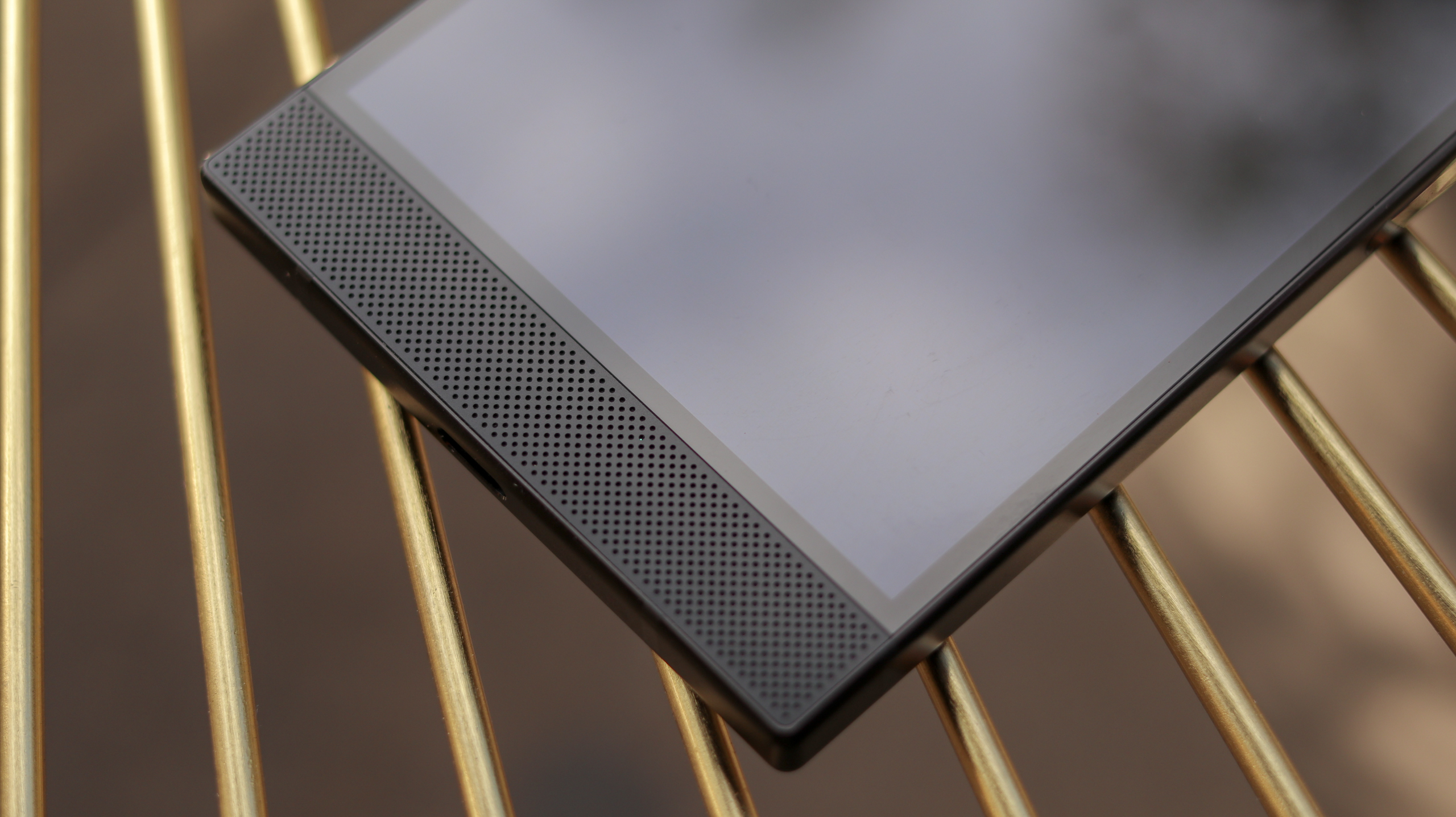
If you get some time with the Razer Phone 2, we would urge you to try out the Dolby Atmos demo within the settings. The sound separation it showcases is unlike anything we’ve used before on a phone – it’s quite breathtaking.
Regular content also sounds great, and while the Pixel 3XL may be a bit louder volume isn’t everything, and we’re confident you won’t be disappointed if you care about audio and pick up the Razer Phone 2.
This audio excellence also extends to the supplied USB-C to 3.5mm jack adapter, which features a 24-bit DAC, and sounds tangibly better than other supplied adapters we’ve used.
Storage and connections
64GB of storage is less than we would have hoped to see in the Razer Phone 2. Given that devices like the Motorola One, Honor 8X and Honor Play cost less than half the price of the Razer Phone 2 and also ship with 64GB, it’s disappointing that we didn’t get 128GB in this premium gaming phone.
It does offer microSD card expansion; however, large games often have to be installed on the internal storage, and when Fortnite is 2.54GB, Monster Hunter over 3GB and Injustice 2 over 1GB, that’s more than 10% of the phone’s storage gone on just three games.
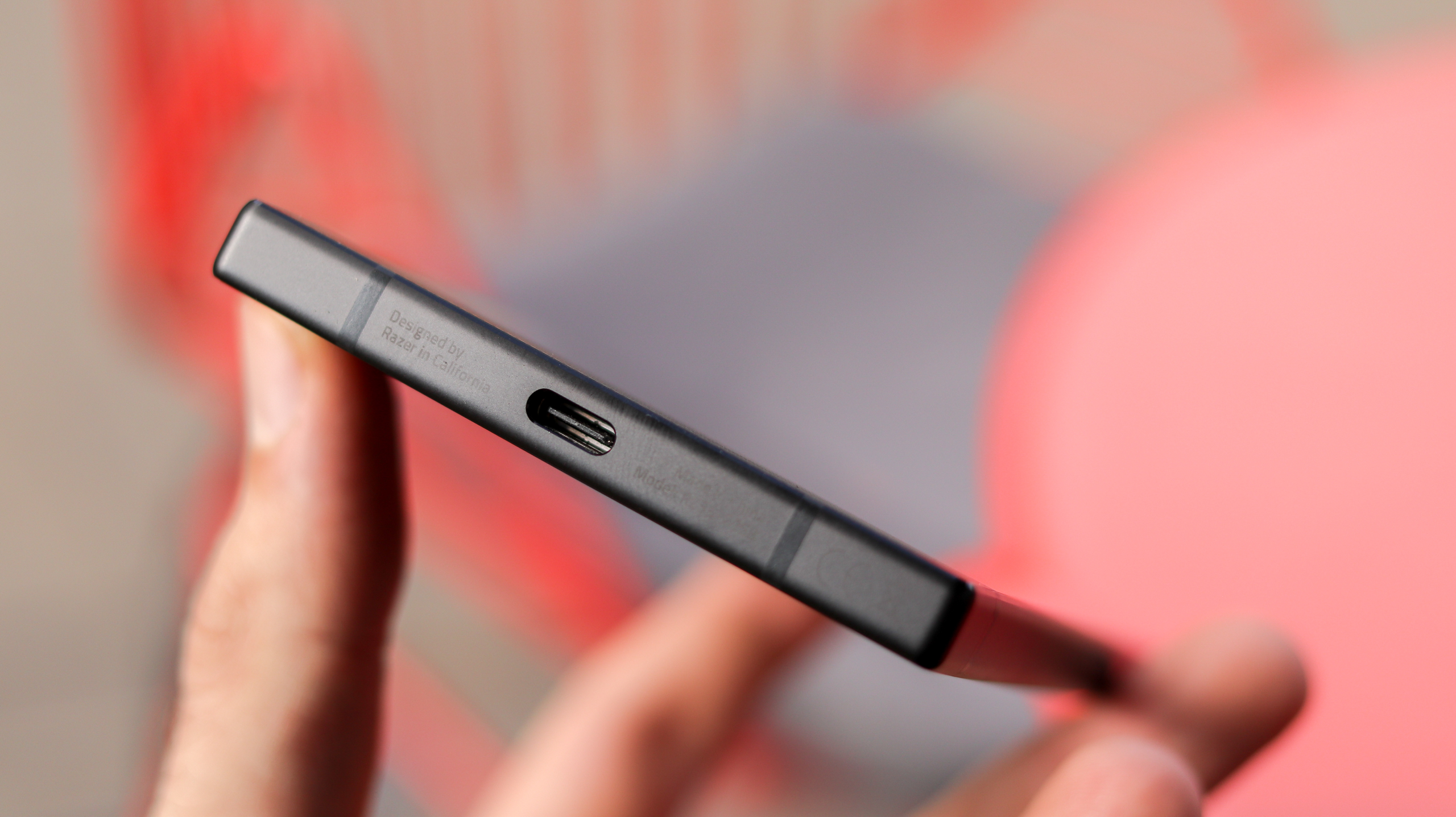
If you end up getting the Razer Phone 2 and know that you’ll want loads of games on it, we’d advise you to get an SD card, and set your phone’s camera to save all your photos and videos to it, to keep more of the built-in storage free for games.
The other connections are respectable. The Snapdragon 845 delivers download speeds of up to 1.2Gbps, there’s Bluetooth 5.0 onboard, and, as mentioned, there’s a USB-C to headphone jack adaptor in the box.
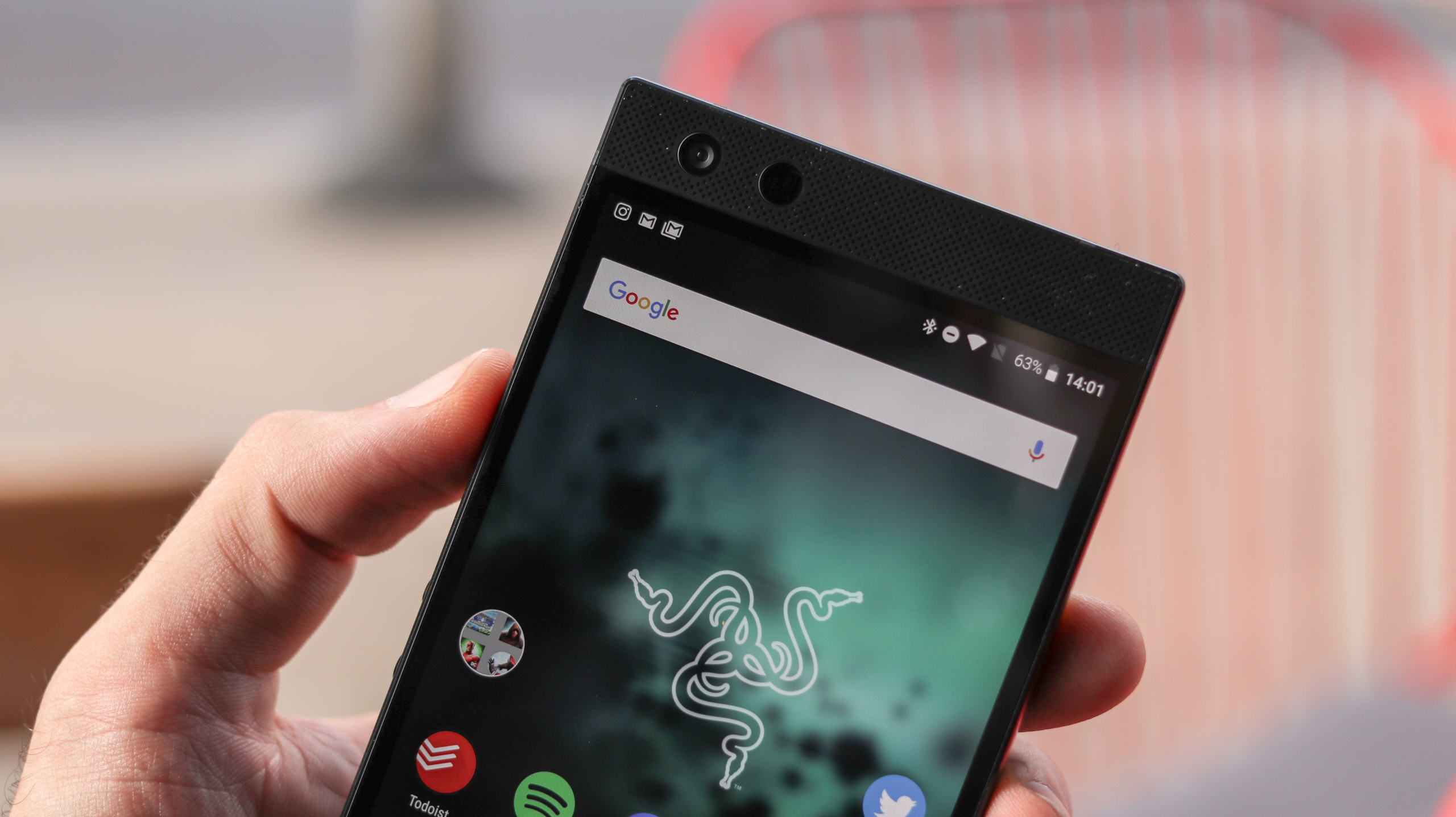
Verdict
The Razer Phone 2 is great for gaming, there’s no denying that. You know what else is great for gaming? The Pixel 3, Mate 20 Pro, Note 9, Xperia XZ3… we could go on.
While the 120Hz screen makes the Razer stand out, all those other phones have powerful processors, IP67 water resistance or higher, stereo speakers, wireless charging, and at least the same amount of storage.
And where last year Razer had an incredibly competitive price on its side, this year it’s charging flagship buck.
What’s even more challenging here is that the OnePlus 6T was announced shortly after the Razer Phone 2, with the 8GB RAM version undercutting the Razer in a big way. While it doesn’t pack 2K 120Hz goodness, we’d take OnePlus’ OLED screen tech over the Razer Phone’s IGZO display in a heartbeat for everything other than gaming.
Add to that the fact that the Asus ROG phone is hot on Razer’s heels, and even amongst gamers the Razer Phone 2 isn’t the obvious choice.
So, while the Razer Phone 2 is seriously good – we’ve loved our time reviewing it – knowing what else is on the market for a similar asking price, it isn’t easy to recommend it, unless of course you’re an RGB-loving gamer who lives an overclocked life at 120Hz.
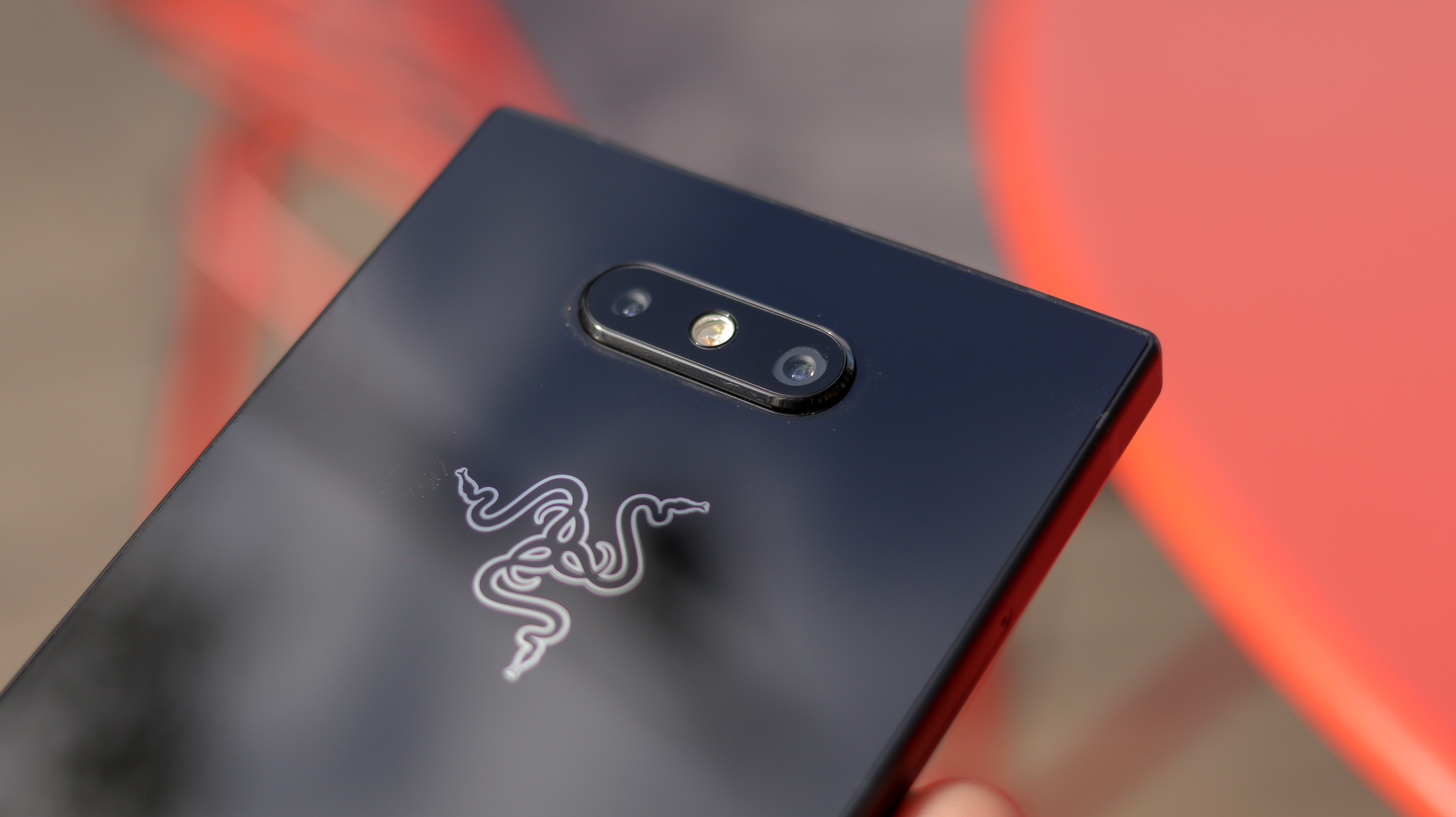
Who it's for
Gamers are the obvious target market for the Razer Phone 2. If you are one, everything here is geared for you – the speakers, the screen, the power and the shiny shiny RGBs.
The Razer Phone 2 is also for anyone who wants a great sound experience from their smartphone. Whether from the stereo speakers or the supplied USB-C to 3.5mm adapter, in comparison to other flagships the Razer Phone 2 is uncompromising when it comes to sound quality.
Finally, anyone who likes statement phones with clean, classic styling may also love the Razer Phone 2. Its bold look and Chroma logo marry to create something that’s assertive, and different to anything else on the market – other than the original Razer Phone, of course.
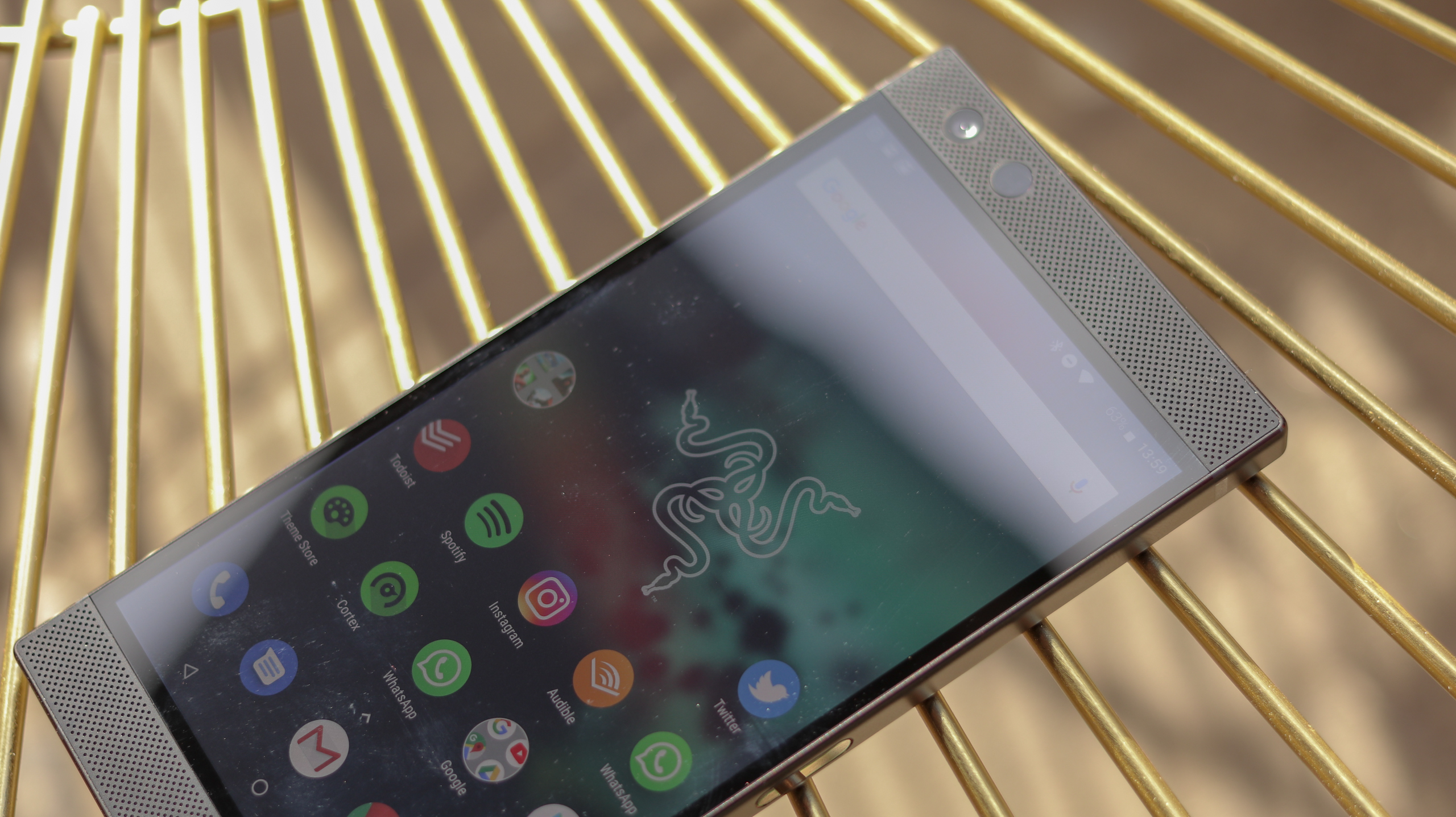
Should I buy it?
If you can get the Razer Phone at a great price, and want power, RGB lighting and a great gaming experience, absolutely – the question is, can you get all, or most of those things elsewhere for less?
Looking for other options? Check out the following Razer Phone 2 alternatives:
Galaxy S9 Plus
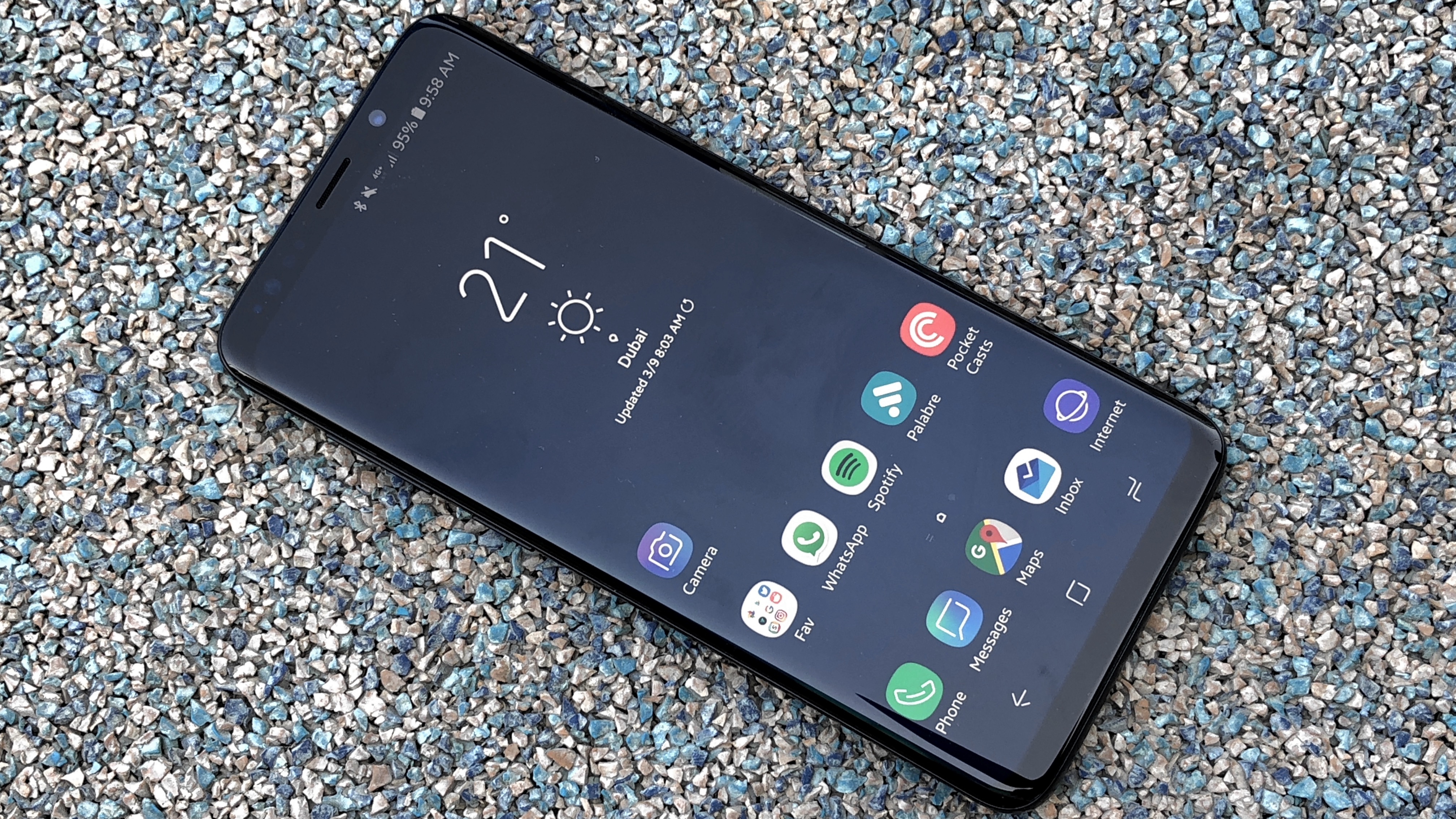
The Galaxy S9 Plus has a bigger, taller screen than the Razer Phone 2. It also has an excellent camera that supports dual apertures, edging ahead in low light. The fact that it’s been out for a while now means the price will likely undercut the Razer Phone 2 in your region, and while it may lack the RGB Chroma logo, it does pack a beautiful 2K OLED curved display.
Read our full Samsung Galaxy S9 Plus review
Huawei Mate 20 Pro
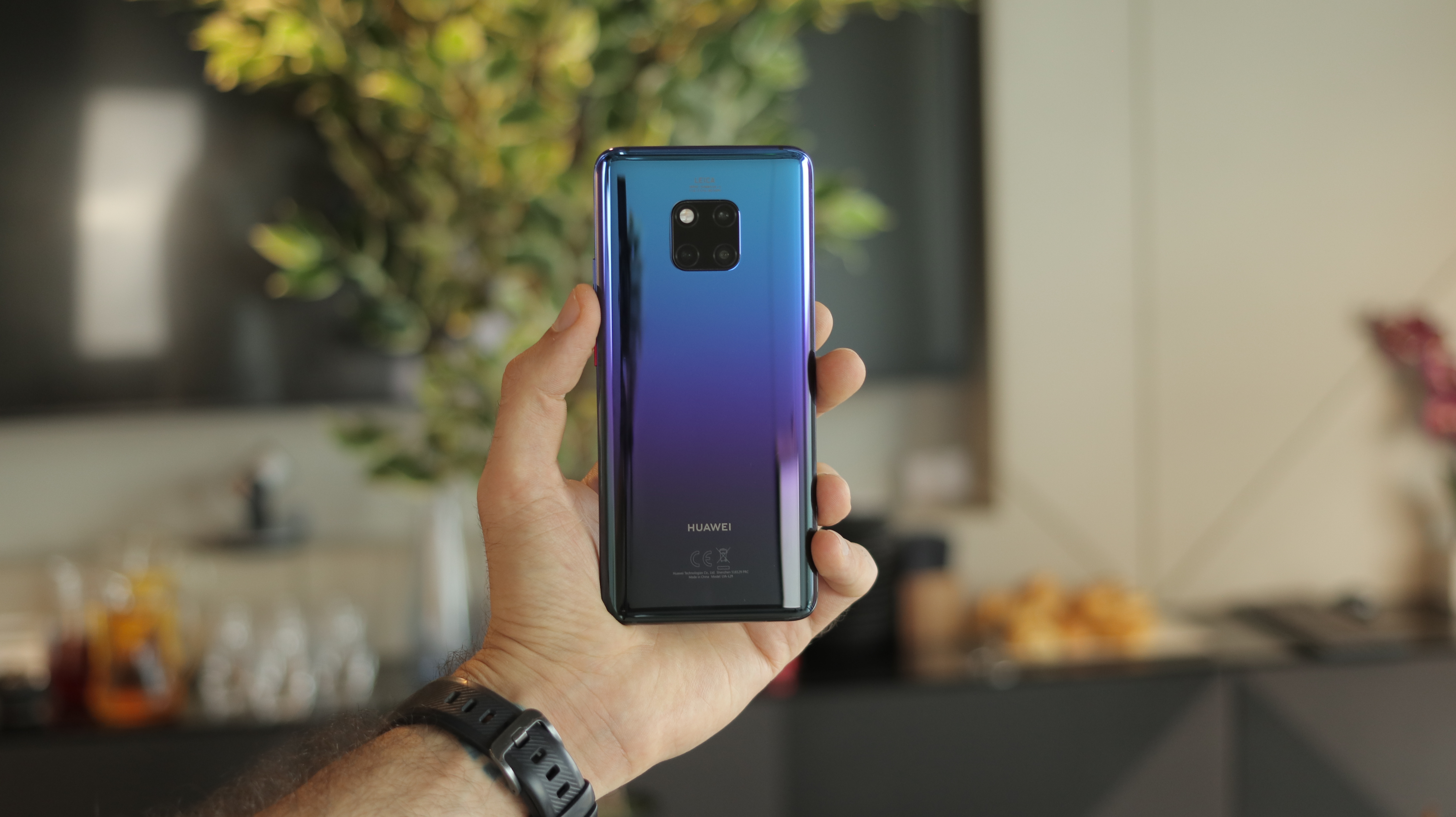
With its triple camera, the Huawei Mate Pro is a different beast to the Razer Phone 2 from an imaging point of view, offering an ultra-wide-angle lens as well as a 3x zoom telephoto lens. It has a curvaceous look and feel, a notch and OLED screen technology for deeper colors – although no 120Hz refresh rate. With a larger 4,200mAh battery it lasts for longer than the Razer Phone, and features both wireless and reverse wireless charging, but it costs more.
Read our full Huawei Mate 20 Pro review
iPhone XS Max
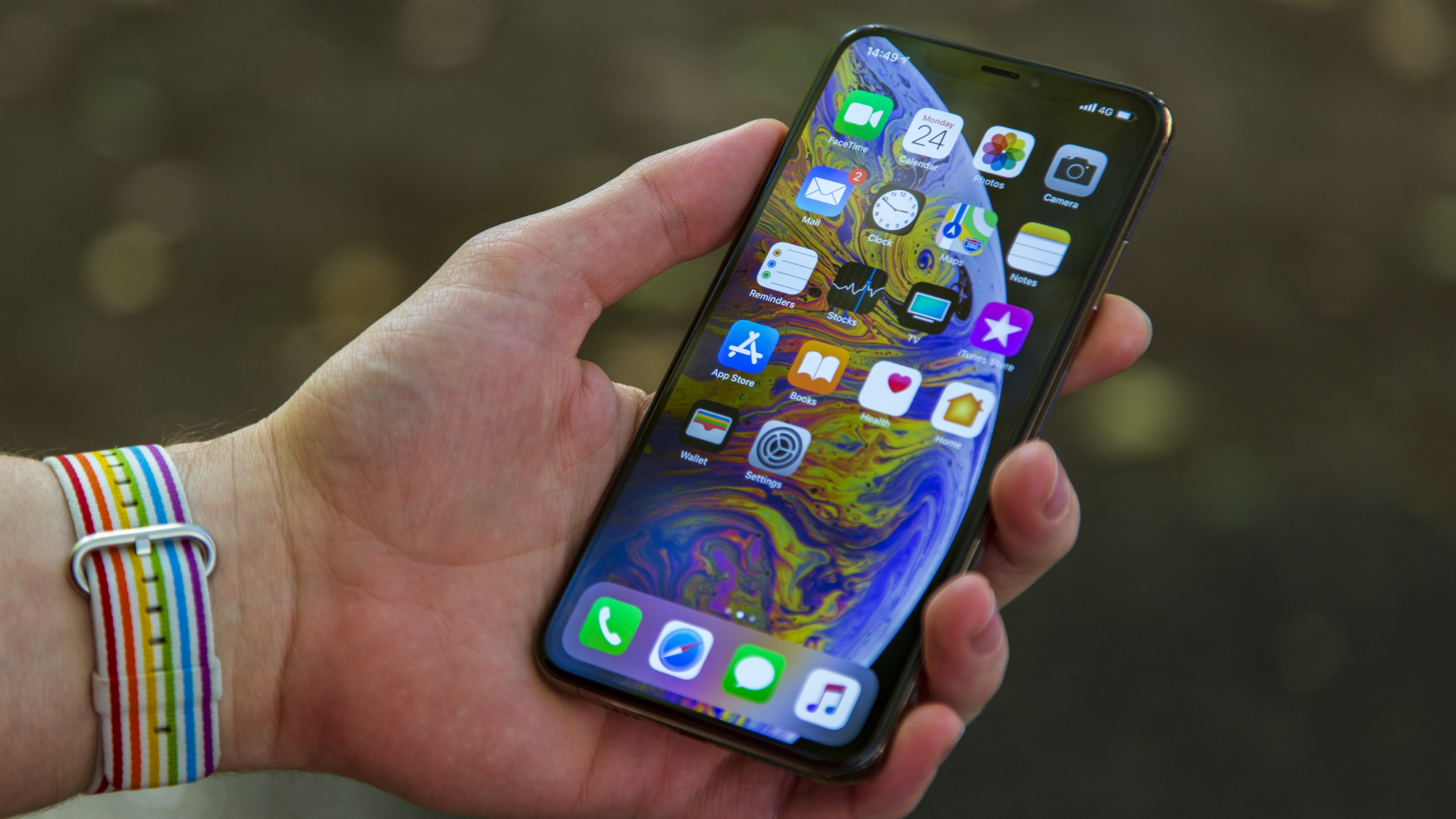
The iPhone XS Max delivers much more screen and less bezel than the Razer Phone 2. Still featuring stereo speakers and packing stacks of power under the hood, it’s an excellent gaming machine, but the iPhone and iOS in general will cost you more than the Android-running Razer Phone 2 if you’re looking to load it up with the latest, greatest titles. The iPhone also packs a markedly superior camera.
Read our full iPhone XS Max review
OnePlus 6T
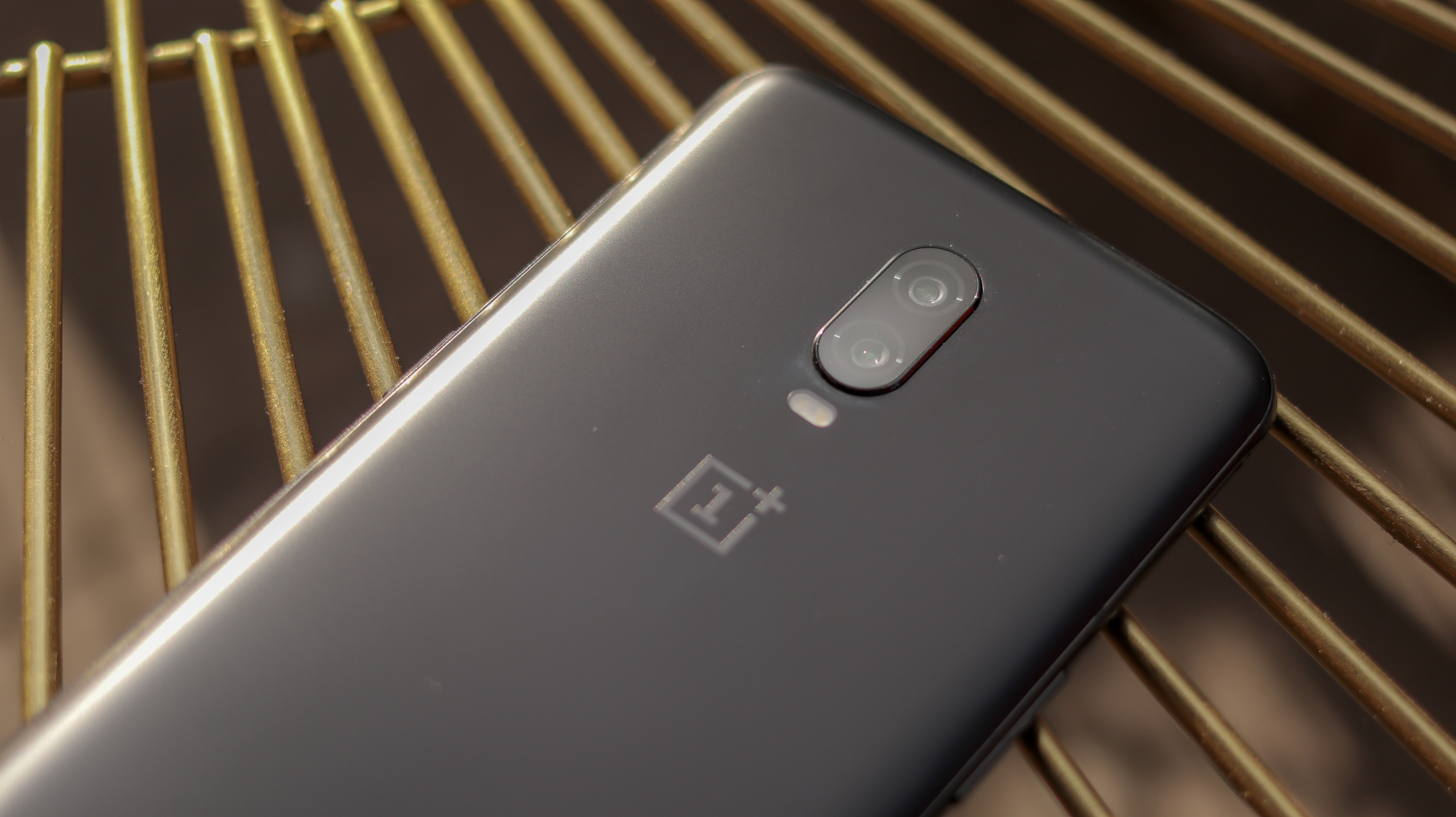
The OnePlus 6T manages to deliver the same Snapdragon 845 chipset, up to 8GB RAM and more storage, with a base capacity of 128GB. While it doesn’t have microSD card support, we’d pick double the internal storage over a card slot anyday. That said, for gaming, the Razer Phone wins out thanks to far superior speakers that are near impossible to cover up, and a more gaming-centric shape.
Read our full OnePlus 6T review
0 comments:
Post a Comment